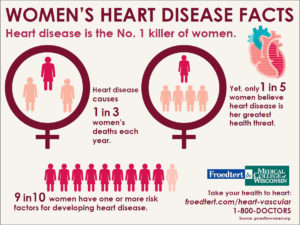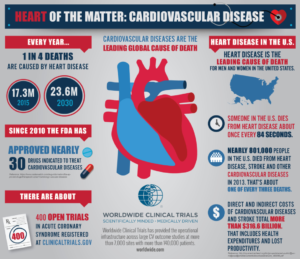THE HEART:
The heart is a muscular organ in most animals, which pumps blood through the blood vessels of the circulatory system. Blood provides the body with oxygen and nutrients, as well as assists in the removal of metabolic wastes. In humans, the heart is located between the lungs, in the middle compartment of the chest.
WHAT IS CARDIOVASCULAR DISEASE:
Cardiovascular disease (CVD)—including heart disease, stroke, and high blood pressure—is the number 1 killer of women and men in the United States. It is a leading cause of disability, preventing Americans from working and enjoying family activities.1 CVD costs the United States over $300 billion each year, including the cost of health care services, medications, and lost productivity.
Heart disease describes a range of conditions that affect your heart. Heart diseases include:
- Blood vessel disease, such as coronary artery disease
- Heart rhythm problems (arrhythmias)
- Heart defects you’re born with (congenital heart defects)
- Heart valve disease
- Disease of the heart muscle
- Heart infection
Understanding the Burden of CVD:
CVD does not affect all groups of people in the same way. Although the number of preventable deaths has declined in people aged 65 to 74 years, it has remained unchanged in people under age 65. Men are more than twice as likely as women to die from preventable CVD.
Having a close relative who has heart disease puts you at higher risk for CVD. Health disparities based on geography also exist. During 2007–2009, death rates due to heart disease were the highest in the South and lowest in the West.
Race and ethnicity also affect your risk. Nearly 44% of African American men and 48% of African American women have some form of CVD. And African Americans are more likely than any other racial or ethnic group to have high blood pressure and to develop the condition earlier in life. About 2 in 5 African American adults have high blood pressure, yet fewer than half of them have the condition under control.
Many CVD deaths could have been prevented through healthier habits, healthier living spaces, and better management of conditions like high blood pressure and diabetes.
You can control a number of risk factors for CVD, including:
-Diet
-Physical activity
-Tobacco use
-Obesity
-High blood pressure
-High blood cholesterol
-Diabetes
As you begin your journey to better heart health that can last a lifetime, keep these things in mind:
1-Try not to become overwhelmed. Every step brings you closer to a healthier heart, and every healthy choice makes a difference!
2-Partner up. The journey is more fun—and often more successful—when you have company. Ask friends and family to join you.
3-Don’t get discouraged. You may not be able to take all of the steps at one time. Get a good night’s sleep—also important for a healthy heart—and do what you can tomorrow.
4-Reward yourself. Find fun things to do to decrease your stress. Round up some colleagues for a lunchtime walk, join a singing group, or have a healthy dinner with your family or friends.
Revised 2/16/2021



